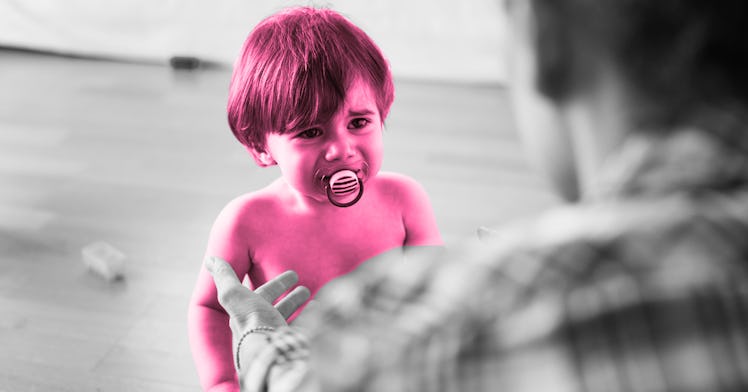How to Properly Use a Pacifier
Using a baby pacifier can be helpful, but there are also reasons you might hold off. Check out the pros and cons of pacifiers and make an informed choice.

A pacifier seems pretty intuitive — just plug the sucker in when the kid acts up, right? Turns out that’s not exactly the case. Pacifiers are not necessarily the appropriate response every time a baby is fussy or unhappy. Babies reflexively suck to sooth, so it can certainly help a distressed baby settle down. But that makes it pretty easy to abuse this particular “mute” button, and that can have long-lasting implications for the baby.
Andrea Tran is a nurse, a blogger, and a lactation consultant for over 24 years. She’s seen how overuse of a pacifier interferes with breastfeeding, and before a child’s nursing schedule is established, introducing a pacifier just confuses the issue.
RELATED: How to Introduce a Baby to a Pacifier
“New mothers often don’t understand that frequent breastfeeding is normal and helps bring her milk in,” explains Tran. “They often will give their baby a pacifier so the baby won’t breastfeed so often. This will decrease the stimulation she gets and can delay the milk from coming in.”
Using a pacifier to put off feedings interferes with the baby’s nutrition and the mother’s ability to meet those nutritional needs. And breastfeeding can be hard enough; the wrong kind of pacifier can make feeding even harder, at least on moms.
How to Use a Pacifier Properly
- Know when to introduce the pacifier: A mother and a child need to figure out breastfeeding before a pacifier can be used; they not only can confuse and delay feeding, but change the way a baby suckles.
- Keep them clean: Sure, kids put things in their mouths, but parents shouldn’t be blasé about introducing unnecessary germs. Swap out a dropped pacifier for a clean one.
- Use them for bedtime: Day or night, a pacifier used when a baby goes down to sleep can reduce the occurrence of SIDS in the first year.
- Don’t use a pacifier to solve problems it can’t: a pacifier isn’t a substitute for changing a wet diaper, feeding a hungry baby, or letting a tired infant sleep.
- It isn’t the only way to sooth: shushing and swaying help a baby settle down after they grow upset, and give parents and child an opportunity for loving interaction.
- Overuse is expensive: using a pacifier several hours a day into toddlerhood can change the shape of the mouth in a way braces can’t fix.
“Certain pacifier shapes, such as orthodontic-shaped pacifiers, can encourage incorrect sucking. That can result in sore nipples,” notes Tran. “I have worked with several moms who started to experience sore nipples after starting to use an orthodontic-shaped pacifier.”
That doesn’t mean pacifiers are no good. Tran points to an American Academy of Pediatrics study that finds that using a pacifier appropriately can reduce the chance of SIDS.
“As part of reducing the incidence of SIDS a pacifier should be offered at times of sleep, both day and night,” Tran advises. This benefit seems to be for when the baby is falling asleep; if the pacifier falls from a sleeping baby’s mouth, it’s not necessary to replace it.
After the risk of SIDS has greatly decreased around the first birthday, so do the health benefits of a pacifier. Unfortunately, babies grow used to them. Giving up a pacifier can be hard on a kid – and parents – but the consequences of overuse can be hard on the budget.
Stephanie Aldrich, DDS, has been practicing dentistry for 19 years, and she has seen the damage that prolonged pacifier use can cause. It doesn’t merely interfere with adult teeth. Sucking on anything for hours a day, be it a pacifier or thumb, can change the shape of the mouth itself.
“Pacifiers and thumb sucking can put pressure not only on the front teeth but also the hard palate, causing it to grow forward or even up,” says Aldrich. “Have you ever seen someone who is smiling, and their teeth are closed in the back, but their front teeth stick out and aren’t touching? This is called an open bite.”
The problem, says Aldrich, is that children’s faces grow so much during their first five years, too much sucking can shape the palate into a V-shape that can cost tens of thousands of dollars in surgeries to correct – if it can be corrected at all.
“A newborn or baby that isn’t teething yet can benefit from a pacifier due to it suckling instinct,” says Aldrich. “But once the child is eating solid food and has some teeth, the pacifier needs to go away! If not, it can lead to extensive and costly damage to the teeth and palate that may not be able to be fixed.”
Parenting is all about putting out fires in the day-to-day with an eye toward the future. Pacifiers are just one tool they have to keep a baby happy. Overusing it can turn a short-term solution in a long-term problem.